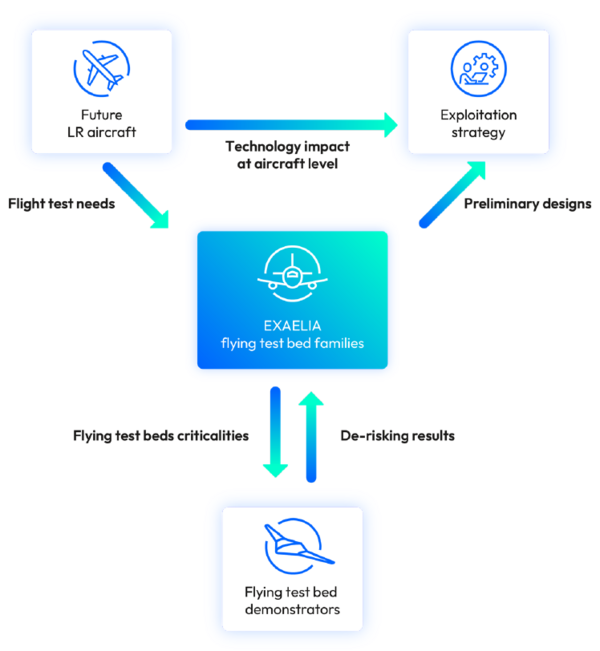EXAELIA (EXperimental Aircraft for European Leadership in Aviation) aims at de-risking the development of radically new future long-range aircraft that incorporate a step change towards climate neutrality before 2050. The goal is to deliver validated designs and exploitation plans for large-scale European flying testbed (FTB) assets for this purpose.
The EXAELIA overall methodology relies on several pillars of knowledge that are used to develop the critical technologies required for future FTBs:
- Investigation of disruptive future long-range aircraft configurations with breakthrough technologies
- Design of FTB families for flight testing to de-risk criticalities
- Development of FTB demonstrators
- Strategy for exploitation of the EXAELIA modular FTBs and the investigated aircraft configurations
EXAELIA focuses on maturing two aircraft configurations, (1) Blended Wing Body (BWB), and (2) Tube-and-Wing (TAW), aiming for entry into service between 2045 and 2050. Two variants of the BWB aircraft, using Sustainable Aviation Fuel (SAF) or Liquid Hydrogen (LH2), and a single variant of the TAW configuration with LH2 fuel, will be investigated. The exploration of these revolutionary aircraft concepts is followed by the development of FTB families and their small-scale demonstrators for long-range BWB, long-range LH2 TAW and for long-range propulsion systems.
With the FTBs developed towards preliminary design, it is an essential part of the project to prepare for the direct exploitation of the FTB designs. The stakeholders of EXAELIA FTBs are aircraft and engine manufacturers, aviation policy makers and aviation research organizations.
Bauhaus Luftfahrt contributes to the project as follows:
- Investigation of the design of a composite cycle engine (CCE) with a free-double-piston engine as an innovative propulsion concept for the long-range LH2-TAW configuration.
- Preparation of flight test needs for an aircraft equipped with the CCE propulsion system.
- Contribution to the flying test bed design and exploitation strategy for the studied aircraft configuration and propulsion system.
Sitchting Koninklijk Nederlands Lucht- en Ruimtevaartcentrum (NLR); Koordinator
Office National d'Études et de Recherches Aérospatiales (ONERA)
Deutsches Zentrum für Luft- und Raumfahrt (DLR)
C.I.R.A. Centro Italiano Ricerche Aerospaziali SCPA (CIRA)
Siec Badawcza Lukasiewicz-Instytut Lotnictwa (ILOT)
Instituto Nacional de Técnica Aeroespacial « Esteban Terradas » (INTA)
Institutul National de Cercetare-Dezvoltare Aerospatiala « Elie Carafoli » (INCAS)
AIT Austrian Institute of Technology
CEiiA – Centro De Engenharia e Desenvolvimento (Associacao)
EASN Technology Innovation Services BVBA
Aristotelio Panepistimio Thessalonikis (AUTH)
Institut Supérieur de l’Aéronautique et de l’Espace
Technische Universität Braunschweig





